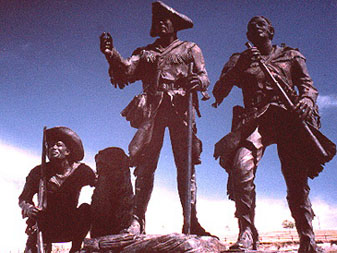GEORGE CATHCART'S
LEWIS AND CLARK JOURNAL
The record of a motor trip in the
footsteps of the Corps of Discovery
Week 1

|
GEORGE CATHCART'S The record of a motor trip in the
footsteps of the Corps of Discovery |
 |
|
In the summer of 1996 I undertook
to drive from St. Louis, Missouri, to the Oregon Coast, following
as closely as possible the route taken by Lewis and Clark's Corps
of Discovery nearly 200 years earlier. I had finished the first
draft of a novel, "The Memoirs of Hugh
Hall," about one of the less-known soldiers who participated
in that grand exploration of the newly acquired and largely unknown
Louisiana Territory. Although I had visited the Oregon, Washington,
Idaho and some of the Montana portion of the route, I had never
seen most of the country through which the expedition passed
as it made its way up and down the Missouri River: Missouri and
Kansas, Iowa and Nebraska, the Dakotas and the badlands of eastern
Montana. My plan was to stay as close to the river as possible,
stop and observe frequently and spend my evenings editing my
manuscript. I wanted to experience the hardships as much as I
could, so I left my air conditioner off, did not wear sunglasses
or mosquito repellent (after the first few days), and camped
out every night. |
7-6-96 7 p.m. Wood River, Ill.Impressions: Beer-drinking fishermen wait
by poles for fish to take bites... The site is surrounded by
dark deciduous swampy woods. They will be grey, cold and wet
in winter. Across from me, the Missouri mouth is dense woods
on the south bank, a sparsely wooded island or spit on north
bank. The Mississippi current overpowers the little Wood River,
but is not as formidable as feared. |
|
7/8 8:45 a.m. Marshall,
MO,
at a café. Three farmers linger over coffee and talk softly. They seem remarkably calm about the morning's welcome rain. Farming is like baseball. You don't celebrate every hit. A long drought is right around the corner. Yesterday I felt a lot like Hugh Hall, trying to escape the lower river. I had a long but fruitful visit to the museum at Jefferson National Expansion Memorial at St. Louis, and a lengthy stay in St. Charles. I didn't get going up the river until about 1:30. Then I felt like I was racing the clock. I passed up a few nice bucolic farm scenes I should have photographed. But I did stop by the river whenever I had a chance. The backroads that bear the Lewis and Clark Trail symbol wind narrowly along ridge-tops and through fields of tasseled corn. They follow the land, so they wind almost at random, unlike the Interstate, which ignores the land and plows ahead. Manifest Destiny. I like Interstates when I have a destination, but they bore me, and I often have to fight off 70-mile an hour naps. On this journey, the destination is whatever I see next. Roads that follow the land show me the land. I saw the Boon's Lick salt works and made it to Arrow Rock. Set up tent, cooked dinner, showered before full dark. Due to clear sky I left the fly off the tent. When I got up to pee about 1:30, many stars were gone, apparently under clouds. An hour later I was putting the fly on the tent in a light shower. By dawn it was raining steadily, with occasional thunder. Stove wouldn't light -- too wet -- so I packed wet and drove on up MO 41 to get gas (out of unleaded regular, out of ice) at Countryside Convenience. Now I'm here for breakfast. |
|
7/9 Lewis and Clark State Park, Iowa, 30 miles south of Sioux City. Not to be confused with L&C
St. Park, Missouri, where I camped last night. |
|
7/10 Snake Creek State Park, S.D. 9:40 p.m. It's still light, but not
enough to write by without the lantern. |
|
7-11 Indian Memorial Recreation Area. Lake Oahe, SD, near Mobridge. So named for Sitting Bull's
Grave and a Sacagawea Monument nearby. |
|
7/13 Lewis & Clark State Park, 16 miles east of Williston, ND, my northernmost campsite on this journey. It has been 2 days since
I last wrote in here, but I have not covered a lot of miles.
Yesterday I went back to Mobridge to see the Klein Museum, then
did laundry and wrote postcards and got some groceries before
proceeding on after 11:30 a.m. Tomorrow into Montana. Tonight, now, shower. It's been 2 days. I'm ripe. |
|
|
|